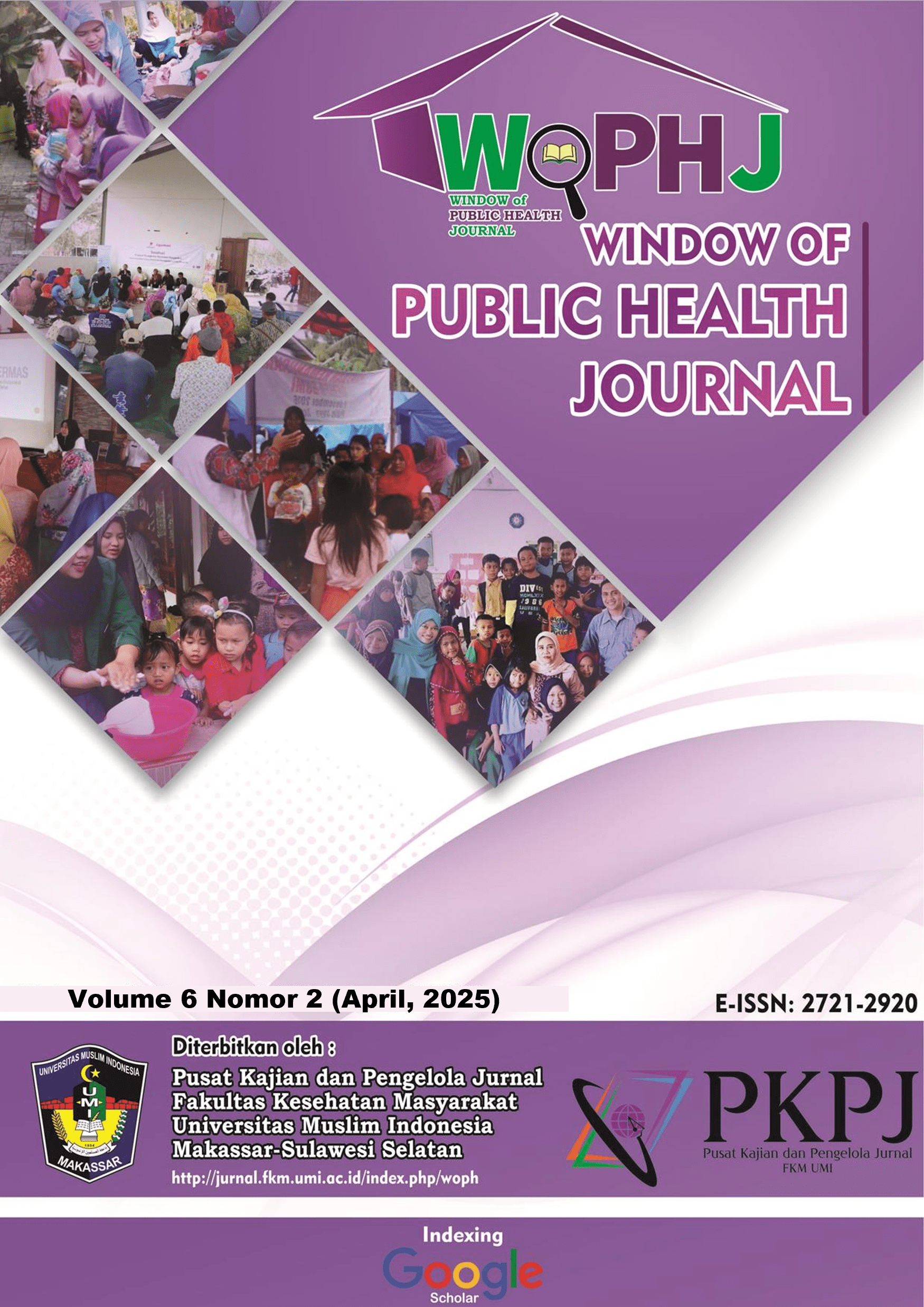Monitoring Deteksi Kanker Payudara Berbasis Aplikasi Ca. Mammae Di Rumah Sakit Ibnu Sina Yw-UMI Kota Makassar
DOI:
https://doi.org/10.33096/woph.v6i2.2105Keywords:
Family history, Age at first menstruation, age at first birth, age of menopauseAbstract
Breast cancer is a disease of excessive growth or uncontrolled development of cells (tissue) in the breast. Breast cancer (Carcinoma Mammae) is defined as a malignant neoplasm originating from the parenchyma. This study aimed to determine the characteristics of breast cancer incidence at Ibnu Sina Hospital YW-UMI Makassar City as the basis for designing the Ca. Mammae application. This type of research uses quantitative research with a descriptive design. The population in this study was outpatients at Ibnu Sina Hospital, Makassar City. The sampling technique used was Accidental Sampling with a sample size of 155 people. The analysis method used univariate analysis to determine the characteristics of breast cancer. The results of this study obtained that breast cancer is the highest based on age at risk of 78.8%, the highest family history of breast cancer is 73.5%, the age of first menstruation based on the category of breast cancer risk is 50.3%, the highest age of first childbirth is the category of breast cancer risk of 80%, history of breastfeeding based on the category of not breastfeeding is 44.5%, the highest age of menopause is the category of breast cancer risk of 51%, parity based on the highest category is nilipara at 44.5%. In comparison, the category of primipara is 40%, and the use of hormonal contraception with the category of hormonal breast cancer is 54.8%. The application of sadari in the category of not applying is 80%. The conclusion of these results shows that there are characteristics of age, family history, age of first menstruation, age of first childbirth, history of breastfeeding, age of menopause, parity, use of hormonal contraception, and the application of Sadari.
References
Mastikana, I. (2020). Hubungan Tingkat Pengetahuan Remaja Putri Tentang Kanker Payudara Dengan Sikap Terhadap Pemeriksaan Payudara Sendiri (Sadari) Pada Siswi Kelas Ii Di Sma Negeri 8 Batam. Jurnal Penelitian Kebidanan, 1(1). Https://Doi.Org/10.52999/Jpkebidanan.V1i1.8
Hero, S. (2021). Faktor Risiko Kanker Payudara. Jurnal Medika Hutama, 3(01 Oktober), 1533–1537.
Hasnita, Y. (2020). Tingkat Pendidikan Dan Pemakaian Kontrasepsi Hormonal Terhadap Kejadian Kanker Payudara. Prosiding Seminar Kesehatan Perintis, 3(1), 139.
Herawati, A., Rijal, S., Arsal, A. S. F., Purnamasari, R., Abdi, D. A., & Wahid, S. (2021). Karakteristik Kanker Panyudara. Fakumi Medical Journal: Jurnal Mahasiswa Kedokteran, 1(1), 44–53.
Azzahra, F. (2022). Hubungan Pengetahuan Tentang Kanker Payudara Terhadap Sikap Remaja Putri Dalam Pencegahan Kanker Payudara. Jurnal Kesehatan Ilmiah Indonesia/Indonesian Health Scientific Journal, 7(2), 52–60.
Kurniati, Y. P., & Nafiah, I. (2022). Fenotipe Estrogen Reseptor Berdasarkan Usia Dan Pekerjaan Pada Kanker Payudara Invasif.
Kurniasih, N., & Rahayu, S. Y. (2020). Hubungan Efikasi Diri Dengan Kualitas Hidup Usia Pertengahan Dengan Kanker Payudara Yang Menjalani Kemoterapi Di Ruang Asnawati RSUP Dr Hasan Sadikin Bandung. Jurnal Sehat Masada, 14(1), 122–131.
Mutiara Putri, I., Wahyu Hidaya, P., & Ismiyatun, N. (2022). TINGKAT PENGETAHUAN DAN FAKTOR RISIKO KANKER PAYUDARA PADA KADER KESEHATAN DI WILAYAH KERJA PUSKESMAS KASIHAN 1 BANTUL YOGYAKARTA. Jurnal Kebidanan Indonesia, 13(1). https://doi.org/10.36419/jki.v13i1.558
Sipayung, I. D., Lumbanraja, S., Fitria, A., Silaen, M., & Sibero, J. T. (2022). Analisa Faktor-Faktor Yang Berhubungan Dengan Kanker Payudara (Ca Mammae) Di RSUD Dr Pirngadi Medan Tahun 2020. Journal Of Healthcare Technology And Medicine, 8(1), 468–476.
Yunus, E. M., Permatasari, N., & Yanti, E. S. (2021). Pengaruh Penggunaan Alat Kontrasepsi Hormonal terhadap Kejadian Kanker Payudara di Fasillitas Pelayanan Kesehatan Effect of Hormonal Contraceptive Use on Breast Cancer Incidence in Health Care Facilities. 9(2).
Komalasari, Y., Fitri, A. E. R., Aziza, K. N., Rahmayanti, V. L., & Fithri, N. K. (2023). Analisis Faktor Reproduksi Sebagai Faktor Risiko Kanker Payudara Pada Wanita Asia Tenggara: Literatur Review. Jurnal Kesehatan Tambusai, 4(2), 1933–1941.
Cahyono, B. E. (2022). Pengaruh faktor karakteristik wanita usia subur dan pasangannya terhadap jarak kelahiran antara anak pertama dengan kedua di Indonesia (Analisis data SDKI 2017). Jurnal Keluarga Berencana, 7(1), 32–43.
Mardiana, A., & Kurniasari, L. (2021). Hubungan pengetahuan pemeriksaan payudara sendiri (SADARI) dengan kejadian kanker payudara di Kalimantan Timur. Borneo Studies and Research, 2(2), 1052–1059.
Downloads
Published
Issue
Section
License
Copyright (c) 2025 Dwita Ayu Israwati, Hasriwiani Habo Abbas, Arman

This work is licensed under a Creative Commons Attribution-NonCommercial-ShareAlike 4.0 International License.







